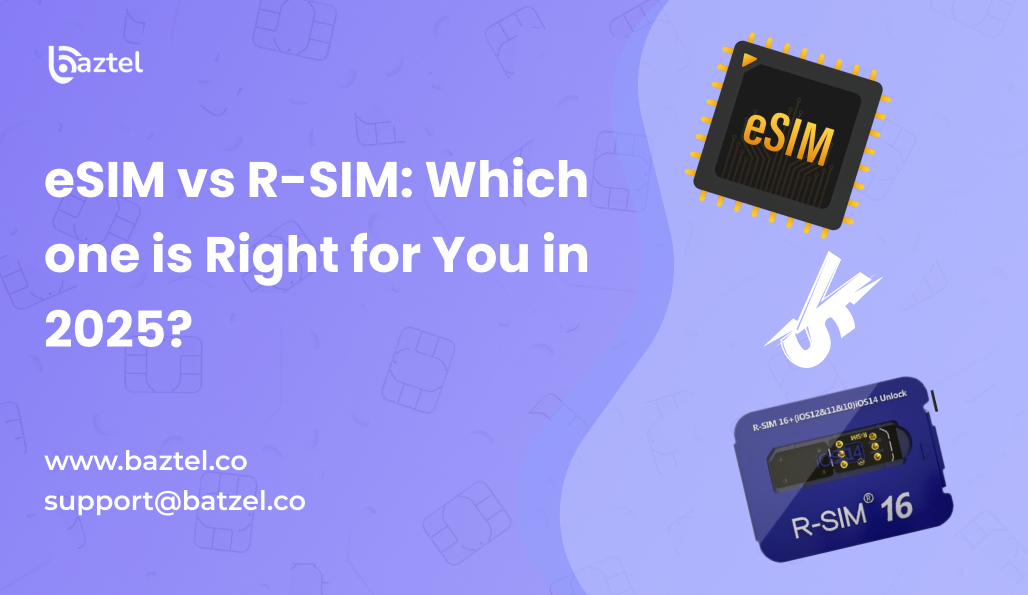Still confused between eSIM and those old R-SIM unlock chips? You’re not alone. In 2025, most travelers and iPhone users are moving to eSIM because it’s digital, quick, and doesn’t need any hardware. If you’re new to the idea, start with how an eSIM works and why it’s different from a plastic SIM: how an eSIM works. This article will also explain the difference between esim and R-SIM, so you can understand which is right for your needs.
eSIM, on the other hand, is a workaround that tricks your phone into accepting a different network. It’s fiddly, version-dependent, and can break after updates. If you’re weighing pure convenience and reliability, this guide will show you where each option stands, who should pick what, and why the shift is happening now. For a quick baseline comparison before we dive in, here’s a refresher on the classic debate: physical SIM vs eSIM
In this blog, you’ll get a complete insight on eSIM vs RSIM. Let’s get started.
What is an Embedded SIM (eSIM) and How Does It Work?
An eSIM (Embedded SIM) is a tiny chip built into your phone or tablet that stores your mobile plan digitally—no need to insert anything physically. eSIMs are embedded directly into the device’s hardware, making them a permanent part of your device. It works just like a regular SIM but lives inside your device and can be updated remotely. You just scan a QR code or install a profile, and you’re live on a mobile network within minutes.
To understand the full setup process, you can check out our step-by-step guide: How to Activate eSIM on iPhone or How to Set Up eSIM on Android. Carrier apps can also be used to easily add, manage, or switch eSIM profiles, providing additional convenience.
This newer SIM format is ideal for travelers, businesses, and tech-savvy users who want flexibility. eSIM technology is also used in other connected devices such as tablets and smartwatches, enabling easier switching between carriers and reducing physical components. You can switch between plans, manage dual numbers, and even install multiple travel eSIMs without opening your SIM tray.
Unlike traditional sim cards, eSIMs cannot be removed or swapped because they are integrated into the device’s hardware. If you’re traveling soon, read how global eSIMs work here: Discover Global eSIM Before Your Next Trip. eSIMs provide network coverage in over 200 countries and regions, making them ideal for using eSIM plans for international travel. eSIMs are supported by most major flagship phones, making them a practical choice for modern travelers.
What is an R-SIM and Why Do People Still Use It?
An R-SIM is a thin chip you insert under your physical SIM card to bypass your iPhone’s network lock on a carrier locked device. It’s mostly used by people trying to unlock carrier-locked iPhones—especially older models. While it does let you use SIM cards from other carriers, it’s not official or stable.
R-SIMs became popular when unlocking fees were high or when people imported iPhones from other countries. R-SIM is often used to unlock carrier restricted phones and other locked devices, providing a physical method to bypass network restrictions. But in 2025, these chips are fading out because most phones now support dual SIMs with eSIM. Plus, Apple’s iOS updates often block R-SIMs, making them unreliable.
If you’re wondering why people still try them—it’s mostly due to cost. R-SIM is sometimes seen as an affordable solution for those who want to unlock their phones without paying high fees. But there’s a catch. Many travelers end up struggling with setup errors and signal drops. It’s far smoother to get an eSIM plan from providers like BazTel and install it instantly. For more insight, read about how eSIMs are replacing traditional SIM hacks: Why It’s Time to Switch.
eSIM vs RSIM: What’s the Main Difference?
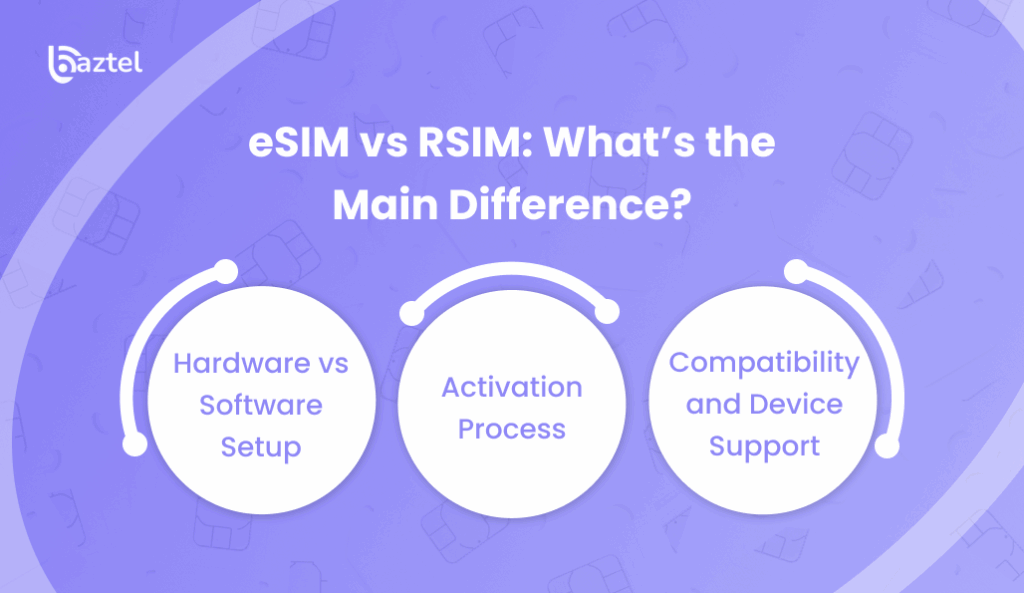
When comparing esim and r sim, it’s important to understand their functionalities and use cases. The key differences between eSIM and R-SIM are that eSIM is a built-in digital SIM allowing you to switch carriers and manage plans easily, while R-SIM is a physical chip used to unlock carrier-locked phones, often for bypassing restrictions. eSIM is an official digital SIM built into your phone.
It lets you download and activate mobile plans instantly—no physical card, no tray. R-SIM, on the other hand, is a hardware trick used to bypass carrier locks on iPhones by placing a chip under your physical SIM. R-SIM only works with physical sim slots and is not compatible with eSIMs.
eSIM is safe, supported by carriers, and perfect for travel. You can switch networks, add plans, and manage everything from settings. R-SIM is risky, often breaks after iOS updates, and is not supported by phone makers.
Want to know how eSIM actually works on different phones? Here’s our full breakdown:
What Is eSIM and How Does It Work?
Hardware vs Software Setup
With eSIM, it’s all digital—no tools, no chips, no hassle. You get a QR code or app link, and your plan is installed instantly. R-SIM needs physical setup, SIM tray handling, and sometimes even jailbreaking.
Activation Process
eSIM plans can be activated remotely, even before you reach your travel destination. R-SIM setup varies and often fails after software updates.
Compatibility and Device Support
eSIM is supported by all major flagship phones—iPhone 13 and above, Samsung S20+, Pixel 5 and newer. R-SIM mainly works on older iPhones, and even then, it’s hit or miss. For full phone compatibility, explore:
Carrier Locked Phone Solutions
Carrier locked phones can be a real headache, especially if you want the freedom to switch carriers or use local SIM cards when traveling abroad. Many users find themselves stuck with a device that only works with their original network, limiting their options and often leading to higher costs. Fortunately, there are several ways to unlock carrier locked phones and regain control over your mobile connectivity.
One common workaround is the use of an R-SIM chip. This small adapter fits into your SIM card tray alongside your physical SIM card, helping to bypass carrier restrictions on locked phones. While R-SIM can sometimes unlock carrier locked devices and let you use local SIM cards, it’s not a perfect solution. R-SIM depends on compatibility with your phone model and carrier, and it can stop working after software updates or with certain network providers.
A more modern and reliable approach is to use eSIM technology. Unlike traditional physical SIM cards, eSIM is built into the device’s hardware and allows you to switch carriers digitally—no need to swap out a physical sim or worry about losing tiny cards. With eSIM, especially on modern iPhones and other newer devices that support eSIM, you can switch networks easily, activate new plans remotely, and even bypass some carrier restrictions without any extra hardware.
Additionally, some carriers offer official unlocking services or provide unlock codes for eligible devices. This is often the safest and most permanent way to unlock a carrier locked phone, allowing you to use any local sim or switch carriers as needed.
When choosing a solution, consider your device’s compatibility, the risks of using third-party tools like R-SIM, and the growing support for eSIM technology in modern smartphones. For most users in 2025, eSIM offers the most convenient and future-proof way to unlock carrier restrictions and enjoy true network freedom.
Is R-SIM Still Safe or Legal in 2025?
R-SIMs have always operated in a grey area. In 2025, they’re not just outdated — they’re being flagged in many countries for legal and safety concerns. Since R-SIM tricks the iPhone into unlocking, it violates Apple’s security protocols. R-SIM is used to bypass network restrictions imposed by carriers, allowing locked phones to be used on different networks. It can stop working after iOS updates and may even lead to network bans or data loss.
Many governments and carriers have started tightening rules around such bypass tools. Remote SIM adapters are another type of device used to unlock carrier-locked phones, helping users bypass network restrictions, especially for locked iPhones and travelers seeking flexible network options. Travelers using R-SIM risk losing signal in foreign countries or getting blacklisted from certain networks. Plus, the support is almost zero. If anything goes wrong, you’re on your own.
Want a legal and stable alternative? Explore these eSIM plans trusted by global travelers:
Best eSIM Plans for International Travel in 2025
Discover Global eSIM Before Your Next Trip Learn how portable WiFi works
Risks Involved with Unlocking iPhones
R-SIM forces your iPhone to skip carrier checks. This often causes SIM errors, dropped calls, or blocked services. You may even void your warranty.
Why Many Countries Are Banning R-SIMs
Due to rising cybersecurity concerns, some nations have banned or restricted import of R-SIM-type devices. It’s seen as unauthorized hardware manipulation — a clear red flag for network providers.
Which is Better for International Travel: eSIM vs RSIM?
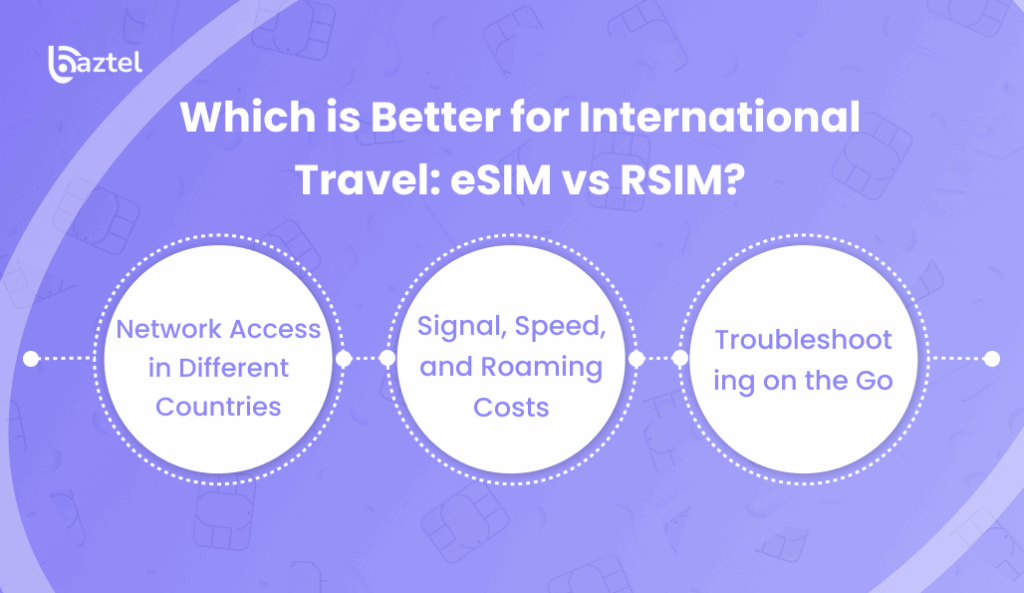
When it comes to international travel, eSIM is the clear winner in 2025. R-SIMs were never meant for global use — they’re mostly hacks to unlock region-locked iPhones. They don’t offer real mobile plans, roaming features, or seamless switching. On the other hand, eSIMs are backed by top telecom providers, come preloaded with regional plans, and can be activated instantly through a QR code.
With eSIM, travelers can easily change carriers when moving between countries, making it much more convenient. eSIM also enables switching between different mobile networks without the need for physical SIM cards. This is a major advantage compared to the traditional process of swapping sim cards every time you enter a new country.
If you’re landing in a foreign country, you don’t want to mess around with SIM trays or risk poor signal. With eSIM, you can switch to a local plan in seconds — no shops, no paperwork. Just buy, scan, and use.
Here are some region-wise plans for smooth international connectivity:
Network Access in Different Countries
When you travel, your phone’s network decides everything — speed, signal, and whether your maps even load. With eSIMs, you can choose the best available network in the country you’re visiting. Most eSIM plans automatically connect to Tier-1 networks, giving you stable internet even in rural spots. R-SIMs don’t offer real mobile plans, so you rely on unlocked device loopholes, which often fail in countries with strict telecom rules or newer bands.
Signal, Speed, and Roaming Costs
Signal drops during travel are frustrating, especially when you need directions or need to book a ride. eSIMs give you direct access to strong 4G or 5G signals using official roaming agreements or local connectivity. With R-SIM, you’re piggybacking on an outdated unlock trick, not an actual plan. That means patchy signal, slow speeds, and expensive roaming charges that may hit without warning. For smooth connectivity, eSIM always comes out ahead.
Troubleshooting on the Go
If your eSIM plan stops working, you can swap it in seconds. Just scan another QR code or switch plans in your app. You don’t need to find a store or remove any SIM. R-SIM has no such flexibility — once it fails, you’re stuck. And if a country blocks R-SIM use, you lose access completely. Travelers need tools they can rely on mid-journey, and eSIM gives you that backup and control.
Local Data Plans with eSIM
Traveling abroad or moving between countries used to mean hunting for a local SIM card and swapping it into your phone’s sim tray. With eSIM technology, that hassle is a thing of the past. Local data plans with eSIM let you purchase and activate a digital sim card directly from your device, so you can connect to local networks without ever touching a physical sim card.
The process is simple: choose a local data plan from a provider that supports eSIM, scan a QR code, and your new plan is ready to use within minutes. This digital approach means you can switch carriers or plans on the fly, making it perfect for frequent travelers or anyone who needs to switch networks for better coverage or rates.
One of the biggest advantages of eSIM is the ability to store multiple carrier profiles on the same device. You can keep your home number active while adding a local data plan for your trip, or switch between different carriers as you move between countries—all without removing your usual sim card. This flexibility gives you a truly hassle free mobile experience, letting you manage your digital sim cards and local data plans right from your phone’s settings.
Many carriers now offer prepaid eSIM options, so you can control your data usage and costs without long-term contracts. Whether you’re traveling for business, vacation, or just want to try a different mobile plan, eSIM makes it easy to stay connected with the best local rates and coverage.
By choosing local data plans with eSIM, you get the freedom to switch carriers, store multiple profiles, and enjoy seamless connectivity—no more searching for a physical sim card or worrying about compatibility with different carriers. It’s the modern way to manage your mobile data, wherever you go.
Which One Works Best for iPhones in 2025?
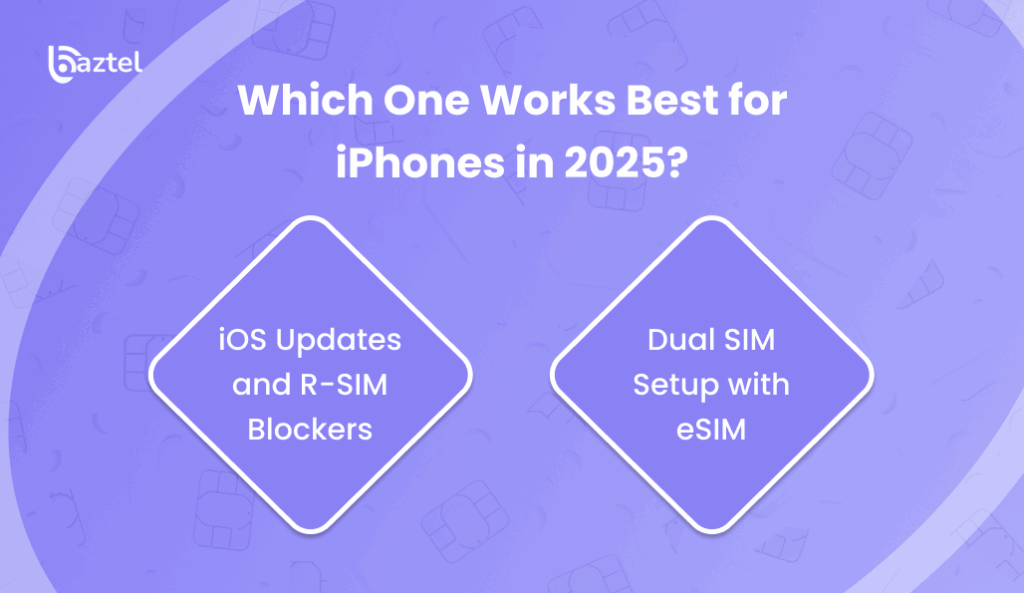
When comparing eSIM vs RSIM for iPhones, it’s important to understand the differences between these technologies. eSIM is a digital SIM that is embedded directly into your device, unlike traditional SIM cards, which are physical, removable cards that have been used in mobile devices for years. This shift from traditional SIM cards to digital SIM technology like eSIM offers greater flexibility and convenience for users.
iOS Updates and R-SIM Blockers
Apple’s regular iOS updates often break whatever trick the R-SIM is using to unlock the phone. So, even if your R-SIM works today, tomorrow’s update can disable it in seconds. Many iPhone users have complained about “SIM Not Supported” messages after updates. With eSIM, this issue never comes up. Apple fully supports eSIM technology — in fact, newer iPhones are removing physical SIM trays altogether. So for long-term use, eSIM stays stable.
Dual SIM Setup with eSIM
One of the best parts about using an eSIM on iPhones is that it still leaves your physical SIM slot free. This is possible because eSIM does not require physical sim slots, allowing you to use the physical slot for another SIM if needed. That means you can run two numbers — one local, one travel — without buying any gadget or modifying your phone. R-SIM replaces your SIM card slot and can’t work alongside another plan. So if you want flexibility, dual data, or to keep WhatsApp on your Indian number, eSIM gives you that edge.
Can You Use Both eSIM vs RSIM on the Same Phone?
Many people assume they can mix and match eSIM vs RSIM to get the best of both. But in reality, this setup rarely works the way you expect. R-SIM works by modifying your phone’s SIM card slot, which can interfere with eSIM functionality and often break compatibility between the two. Some older iPhones might allow both to be activated temporarily, but glitches, signal drops, or software conflicts are very common. For stable use, especially during travel, it’s better to stick to just one — and eSIM offers far fewer headaches.
Pros and Cons – eSIM vs RSIM
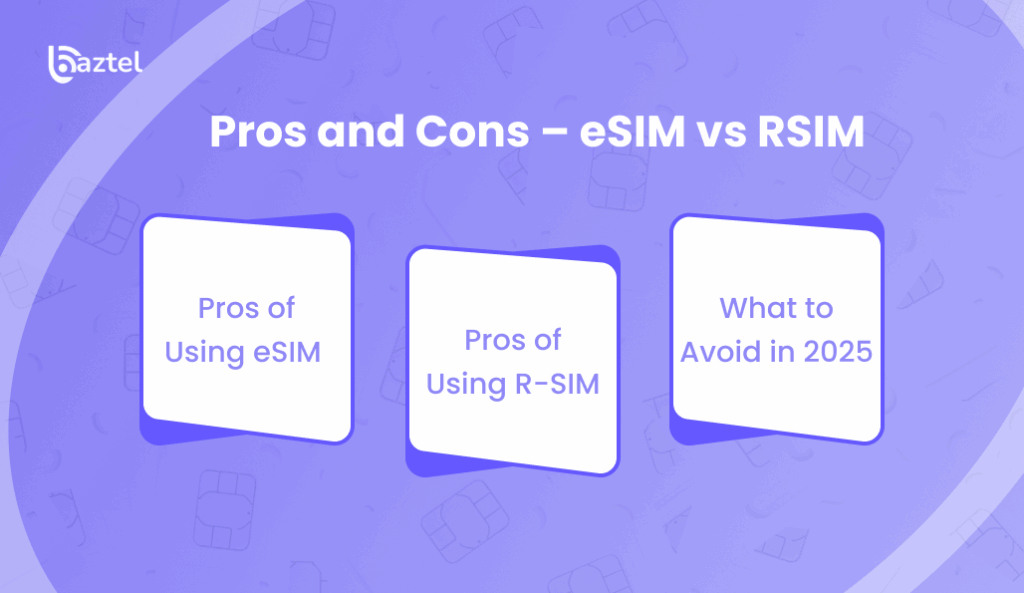
Before you decide which one fits your travel or daily needs, it’s important to weigh both sides. eSIM technology is growing fast because it’s cleaner, safer, and more suited for global connectivity. R-SIMs, on the other hand, are often used to bypass carrier locks on carrier restricted phones, providing an affordable solution for users who want to use their device with different networks — but that comes with risks. Let’s break it down in simple terms so you know what to expect.
Pros of Using eSIM
eSIMs are built for modern travelers. eSIM technology is also widely used in other connected devices such as tablets and smartwatches, allowing these devices to stay connected to mobile networks without physical SIM cards. You don’t have to remove your SIM card or worry about tiny plastic chips. Everything is done digitally — from choosing a plan to activating it. With BazTel eSIMs, you get instant setup, multiple plans on one device, and wide country coverage. If you’re heading to Japan or Australia, just scan the QR and start using data — no tech skills needed.
Pros of Using R-SIM
Some users still prefer R-SIMs because they unlock phones that are locked to a specific carrier. It’s often seen as a shortcut to use foreign SIM cards. If you have an older iPhone model and are not ready to switch to newer tech, an R-SIM may feel like a temporary solution. But do note — many iOS updates disable this trick, and your setup may stop working after a software update.
What to Avoid in 2025
Avoid mixing the two — eSIM vs RSIM — in the same device. This causes conflicts with signal, activation, and roaming. Also avoid using R-SIMs for international travel. They’re not reliable in regions like Europe, UAE, or USA where strong eSIM infrastructure already exists. Stick with trusted eSIM providers that offer secure, legal, and easy-to-manage plans.
Final Verdict – Which One Should You Choose in 2025?
If your goal is smooth connectivity, safer devices, and legal peace of mind, eSIM is the clear winner in 2025. R-SIM had its time, mainly when people wanted to unlock older iPhones or save money on locked handsets. But things have changed. Most new phones already support eSIM. Even budget models are catching up.
R-SIM now feels outdated. It’s not safe, often illegal, and unreliable on iOS updates. It may work today and break tomorrow. Plus, if you’re planning to travel — whether it’s to Canada, Germany, or Singapore — you don’t want to risk losing network access midway. That’s where eSIM shines. It’s built for people on the go. No physical card. No unlock tricks. Just tap, scan, and stay connected.
So if you’re still on the fence, go with the option that’s future-proof — eSIM.
Conclusion
In older days, R-SIM looked like a smart trick. It helped users unlock their iPhones and switch to other networks. But in 2025, things have changed a lot. Phones are smarter. Security is tighter. And the risks with R-SIM are no longer small.
Many users report sudden disconnections, blocked SIMs, or signal drops when using R-SIM. iOS updates often break it completely. Also, in many countries, such unlocking methods are slowly becoming illegal or unsupported.
On the other hand, eSIM is the future. eSIM is a digital sim card, unlike traditional sim cards that require physical insertion. You don’t need to insert anything. No tray, no extra chips. Just scan a QR and get going. It works with modern iPhones, Androids, tablets, and even wearables. You can switch plans anytime, download profiles on the go, and enjoy better global coverage.
So, if you’re choosing between the two: R-SIM feels like an old trick. eSIM feels like a real solution. For clean network access, better travel support, and peace of mind — eSIM wins every time.
Still unsure which eSIM is best for travel? Explore this blog next: Best eSIM Plans for International Travel
FAQs
1. Can I use R-SIM with the latest iPhones in 2025?
Mostly no. iOS updates in 2025 block many R-SIM functions. Even if it works for now, future updates might stop it again. Many users report issues with network drop or activation failure after software updates.
2. Is using R-SIM legal in India or other countries?
It depends on the country. In India, it’s a legal grey area. But in many countries, telecom rules are stricter now, and using unlocking tools like R-SIM may break carrier terms.
3. Why is eSIM better than R-SIM for travel?
eSIM gives instant connectivity without needing to buy or insert any chip. You can activate global plans online, avoid roaming charges, and switch carriers easily. R-SIM can’t do all this.
4. Can I use eSIM vs RSIM on the same phone?
Technically yes, but it’s not reliable. R-SIM often clashes with system settings. If your phone already supports eSIM, there’s no need to use R-SIM at all.
5. Which one is safer — eSIM vs RSIM?
eSIM is way safer. It follows proper security protocols. R-SIM often bypasses system locks, which can make your device unstable or unsafe.
Blog Author
Peter
Peter started BazTel.co to make mobile internet easier for travellers. He noticed how tough it was to find good network options while visiting new countries. That’s when he built BazTel — a place where anyone can buy eSIMs online without confusion or long steps. He believes tech should be simple and useful, not complicated. When he’s free, he likes to travel, test BazTel himself, and keep improving it based on real user problems.

 Botswana
Botswana Zambia
Zambia Congo
Congo Colombia
Colombia China mainland
China mainland Chile
Chile Chad
Chad Central African Republic
Central African Republic Canada
Canada Cameroon
Cameroon Cambodia
Cambodia Burkina Faso
Burkina Faso Bulgaria
Bulgaria Brunei Darussalam
Brunei Darussalam Brazil
Brazil Aland Islands
Aland Islands Bosnia and Herzegovina
Bosnia and Herzegovina Bolivia
Bolivia Belgium
Belgium Belarus
Belarus Bangladesh
Bangladesh Bahrain
Bahrain Azerbaijan
Azerbaijan Austria
Austria Australia
Australia Armenia
Armenia Argentina
Argentina Algeria
Algeria